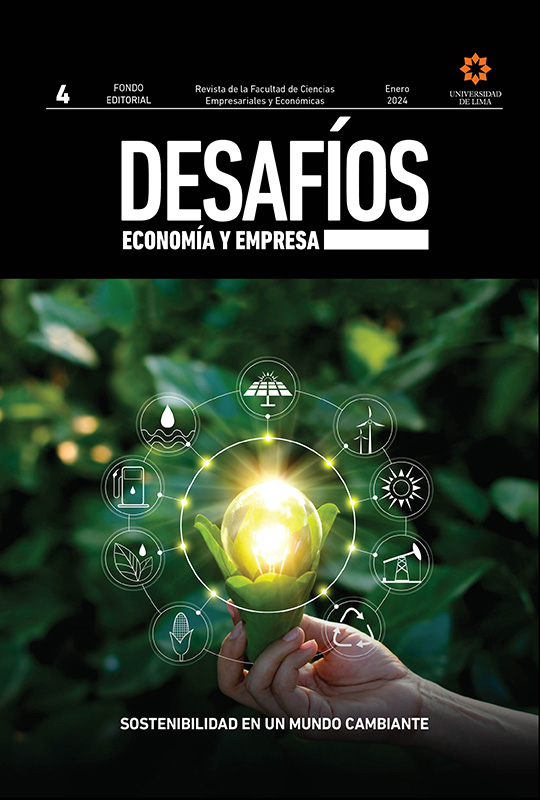Can influencers’ behavior affect consumers’ and investors’ decision-making?
DOI:
https://doi.org/10.26439/ddee2024.n04.6384Keywords:
bounded rationality, heuristic rules, animal spirits, herd effect, influencersAbstract
The aim of this research is to test whether influencers’ behavior guides in some direction consumers’ purchasing decision. In this sense, we have analyzed aspects of economic theory that explain consumers’ behavior when making decisions based on the recommendation of a third party, such as bounded rationality, heuristic rules, animal spirits, and the herd effect. To achieve the objective, several cases in which the actions of influencers are the main reason why the value of an asset, good, or service changes in the market have been developed and analyzed. Relating economic issues with real cases will provide a better explanation of the effect of their actions and will help us understand and explain why these actors are so important. Therefore, it is concluded that influencers do have an impact on consumers’ decision, which is evidenced in the price of the shares.
Downloads
References
Akerlof, G. A., & Shiller, R. J. (2010). Animal spirits: how human psychology drives the economy, and why it matters for global capitalism. Princeton University Press. https://press.princeton.edu/books/paperback/9780691145921/animal-spirits
Ballester, C., & Hernández, P. (2012). Racionalidad limitada. Revista Internacional de Sociología, 70(1), 27-38. https://doi.org/10.3989/ris.2011.10.20
Banerjee, A. (1992). A simple model of herd behavior. The Quarterly Journal of Economics, 107(3), 797-817. https://doi.org/10.2307/2118364
BBC Mundo. (2018, 22 de febrero). Qué escribió en Twitter la celebridad estadounidense Kylie Jenner que le costó US$1.500 millones a Snapchat. https://www.bbc.com/mundo/noticias-43163853#:~:text=”¿Hay%20alguien%20además%20de%20mí,social%20la%20tarde%20del%20miércoles.&text=Un%20simple%20mensaje%20que%20generó,la%20bolsa%20al%20día%20siguiente.
Bikhchandani, S., Hirshleifer, D., & Welch, I. (1992). A theory of fads, fashion, custom and cultural change as informational cascades. Journal of Political Economy, 100(5), 992-1026. https://www.jstor.org/stable/2138632
Claros, F. (2022, 30 de julio). ¿Qué fue de Snapchat, la red social a la que Kylie Jenner le hizo perder US$ 1.300 millones? La República. https://larepublica.pe/datos-lr/respuestas/2022/07/29/historia-de-snapchat-que-fue-de-la-red-social-a-laque-kylie-jenner-le-hizo-perder-1300-millones-de-dolares-evat
Economou, F., Hassapis, C., & Philippas, N. (2018). Investors’ fear and herding in the stock market. Applied Economics, 50(34-35), 3654-3663. https://doi.org/10.1080/00036846.2018.1436145
Estapa, J. (2021, 16 de junio). La millonaria caída de Coca-Cola por el gesto de Cristiano Ronaldo. Marca. https://www.marca.com/futbol/eurocopa/2021/06/15/60c8b1e7e2704ec0478b465c.html
Faulkner, M. C. (2006). Introducción al préstamo de valores. CIFF; Banco Santander.
Fernández, S. (2021, 13 de septiembre). Antonio Banderas y Mario Casas: los secretos de una adicción compartida. Expansión. https://www.expansion.com/fueradeserie/cuerpo/2021/09/13/612cd29ee5fdea2b758b462c.html
Gómez, B. (2018). El influencer: herramienta clave en el contexto digital de la publicidad engañosa. Revista de Ciencias Sociales, 6(1), 4-6. https://doi.org/http://dx.doi.org/10.17502/m.rcs.v6i1.212
Gutiérrez, H. (2021). Cristiano Ronaldo rechaza una Coca-Cola y la empresa pierde casi 4.000 millones de dólares de valor en Bolsa. El País. https://elpais.com/economia/2021-06-15/un-gesto-de-cristiano-ronaldo-le-cuesta-casi-4000-millones-de-dolares-a-coca-cola.html
Hootsuite. (2022). Digital Trends Report 2022. https://www.hootsuite.com/es/recursos/digital-trends
Hotten, R. (2021, 27 de enero). GameStop: cómo inversores aficionados de Reddit se enfrentaron a Wall Street y ganaron (por el momento). BBC News. https://www.bbc.com/mundo/noticias-55833782
Ismiyati, I., Nurlatifasari, R., & Sumarlam, S. (2021). Coronavirus in news text: critical discourse analysis detik.com news portal. Journal of English Language Teaching and Linguistics, 6(1), 195-210. http://dx.doi.org/10.21462/jeltl.v6i1.517
Kahneman, D., & Tversky, A. (1979). Prospect theory: an analysis of decision under risk. Econometría, 47(2), 263-291. https://doi.org/10.2307/1914185
Kasthurirathna, D., Harrè, M., & Piraveenan, M. (2016). Optimizing influence in social networks using bounded rationality models. Social Network Analysis and Mining, 6(1), 1-14. https://doi.org/10.1007/s13278-016-0367-4
Keynes, J. M. (1937). The general theory of employment. The Quarterly Journal of Economics, 51(2), 209-223. https://doi.org/10.2307/1882087
Lin, M. C. (2018). The impact of aggregate uncertainty on herding in analysts’ stock recommendations. International Review of Financial Analysis, 57, 90-105. https://doi.org/10.1016/j.irfa.2018.02.006
Lozano Díaz, Á. (2018). Psicología e inversión en los mercados de capitales. Universidad de Valladolid. https://uvadoc.uva.es/handle/10324/34126?locale-attribute=en
Mercado, A. (2022). Qué es un influencer y cómo puede ayudar a tu marca. https://www.tiendanube.com/blog/pasos-trabajar-influencer/
Morillo, D., Moreno, L., & Díaz, J. (2014). Metodologías analíticas y heurísticas para la solución del Problema de Programación de Tareas con Recursos Restringidos (RCPSP). Ingeniería y Ciencia, 10(20), 203-227. http://www.scielo.org.co/pdf/ince/v10n20/v10n20a13.pdf
Pitta, M. (2020, 18 de noviembre). Neuromarketing: la publicidad de influencers y sus efectos en el consumidor. América Retail. https://www.america-retail.com/neuromarketing/neuromarketing-la-publicidad-de-influencers-y-sus-efectosen-el-consumidor/
Pitta, M. (2022, 18 de abril). Vídeos cortos de TikTok, un material adictivo para el cerebro. América Retail. https://www.america-retail.com/neuromarketing/videos-cortos-de-tiktok-un-material-adictivo-para-el-cerebro/
Reuters Tech News [@ReutersTech]. (2018, 22 de febrero). UPDATE: Snap loses about $1.5 billion in market value following Kylie Jenner’s tweet on Snapchat redesign $SNAP [Tweet]. Twitter. https://twitter.com/ReutersBiz/status/966725620993490950
Robertson, H. (2021, 1 de julio). Dogecoin crece un 7% tras unos tuits de Elon Musk mientras los precios de bitcoin y Ethereum siguen cayendo. Business Insider. https://www.businessinsider.es/dogecoin-crece-7-tuits-elon-musk-mientras-892369
Rodríguez Cruz, Y. (2013). El impacto de la racionalidad limitada en el proceso informacional de toma de decisiones organizacionales. Revista Cubana de Información en Ciencias de la Salud, 24(1), 56-72. http://scielo.sld.cu/pdf/ics/v24n1/ics05113.pdf
Saima, & Khan, M. A. (2020). Effect of social media influencer marketing on consumers’ purchase intention and the mediating role of credibility. Journal of Promotion Management, 27(4), 503-523. https://doi.org/10.1080/10496491.2020.1851847
Sanjulían, A. (2021, 22 de junio). La posverdad del mercado o por qué el gesto de Cristiano Ronaldo no afectó a la acción de Coca-Cola. Forbes. https://forbes.es/empresas/105108/la-posverdad-del-mercado-o-por-que-el-gesto-decristiano-ronaldo-no-afecto-a-la-accion-de-coca-cola/
Scharfstein, D., & Stein, J. (1990). Herd behavior and investment. American Economic Review, 80(3), 465-479. https://www.jstor.org/stable/2006678
Seminario, A. (2022, 4 de noviembre). Emprendedores y redes sociales: ¿Cuánto se debe invertir para crecer y qué plataforma elegir? Perú21. https://peru21.pe/economia/emprendedores-y-redes-sociales-cuanto-se-debe-invertir-para-crecer-yque-plataforma-elegir-facebook-youtube-instagram-tiktok-rmmn-noticia/
Shefrin, H. (2010). Behavioralizing finance. Foundations and Trends in Finance, 4(2) 1184-1186. https://ssrn.com/abstract=1597934
Simon, H. (1955). A behavioral model of rational choice. Quarterly Journal of Economics, 69(1), 99-188. https://doi.org/10.2307/1884852
Superintendencia de Industria y Comercio. (2021, 16 de junio). Superindustria sanciona a Elizabeth Loaiza Junca por publicidad engañosa al promocionar “pruebas rápidas de covid-19”. https://www.sic.gov.co/slider/superindustria-sanciona-elizabethloaiza-junca-por-publicidad-enganosa-al-promocionar-pruebas-rapidas-decovid-19
Vasquez, J. (2018, 22 de febrero). In one Tweet, Kylie Jenner wiped out $1.3 billion of Snap’s Market Value. Bloomberg. https://www.bloomberg.com/news/articles/2018-02-22/snap-royalty-kylie-jenner-erased-a-billion-dollars-inone-tweet
Vries, A., & Stoll, C. (2021). Bitcoin’s growing e-waste problem. Resources, Conservation and Recycling, 175, 1-11. https://doi.org/10.1016/j.resconrec.2021.105901
Yahoo Finance. (2022). Data. https://finance.yahoo.com/lookup?s=DATA


